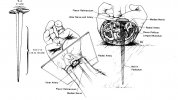windar
Teller of Tales
Crucifixion in Roman Britain
I happened to catch this show on PBS last night about a skeleton discovered in Cambridgeshire, England in 2016 with a nail through its heel. It's only the second such discovery ever -the first was in Israel in the 1960s and was not a complete skeleton. They use a lot of state-of -the-art technology to reconstruct this person's life and even their face. Very much worth a watch.https://www.pbs.org/wnet/secrets/preview-death-in-britannia-4n30pe/7827/
Last edited by a moderator:






